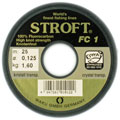 After a lot of preparation and Tests, STROFT is now bringing two new fluorocarbon fishing lines onto the market,
STROFT FC1 and STROFT FC2.
After a lot of preparation and Tests, STROFT is now bringing two new fluorocarbon fishing lines onto the market,
STROFT FC1 and STROFT FC2.Of course, the new lines have also been tested by the EFFTA and as a result FC1 and FC2 will now carry the EFTTA seal of quality. We at STROFT take that for granted, however what we are very proud of is the fact that both FC1 and FC2 have the highest breaking strains that the EFTTA have as yet been able to confirm for fluorocarbon lines.
The linear breaking strain of the STROFT FC 2 is just marginally lower than that of STROFT FC 1. We had been able to production-tune STROFT FC 1 so that it has an exceptionally high knot strength, which of course is somewhat reflected in the price.
For this reason STROFT FC 1 is excellent for traces and STROFT FC2 can also be used as a main line. The manufacturer paid particular attention to the sensitivity and feed-back as well as the resistance to abrasion of both lines. Peak performance can be expected in both these properties, even though the lines can not be classed as particularly hard, they have low elasticity and are best described as being supple and tough.
These new lines have a comparatively low memory, certainly in comparison to other fluorocarbon lines and the thinner lines also cast well from a fixed spool reel. These properties have been confirmed time and again both in our laboratory as well as by our test anglers.
For further general information regarding fluorocarbon lines please see the article “The advantages and
disadvantages of Nylon, Fluorocarbon und Dyneema” in our FAQs section of our website, it’s in German as well
as English and if you wish, we will send you a copy.
The following excerpts point out the main features and differences between STROFT FC lines compared to
STROFT GTM, ABR and Fluor:
- Abrasion-resistance. Very high resistance to abrasion with low rate of absorption (water absorption
0.01%); this value stays constant even after being immersed for several hours, which makes this the
ideal material for use on rocky ground or mussel beds.
- Density. Fluorocarbon is heavier (1.78 g/cm³ as opposed to Nylon 1.14g/cm³), so it tends to sink. That
makes it ideal, if one requires a strong line that sinks quickly.
- Sensitivity. Extreme sensitivity as a result of the minimal load-elongation makes the line particularly
useful whenever lure feedback and bite detection are paramount (spinners, spoons). The relatively high
specific weight of the line results in the line straightening quickly after casting and improves bait contact.
- Casting (fly fishing). The higher specific weight also helps the leader „role out“ nicely on the cast as
well as helping both nymph and streamer presentation.
- Durability. Very high durability as UV-light, saltwater and other aggressive substances have practically
no effect, ideal for sea fishing and wherever high levels of solar radiation are expected.
- Visibility. The refractive index of fluorocarbon is 1.42 as opposed to 1.58 for nylon; as a result it’s closer to that of water which is 1.33. For this reason, it is less visible to the human eye when immersed in clear water.
WAKU GmbH, http://www.waku-angelsport.de
Stroft Fluorocarbon FC1 and FC2 range
Back